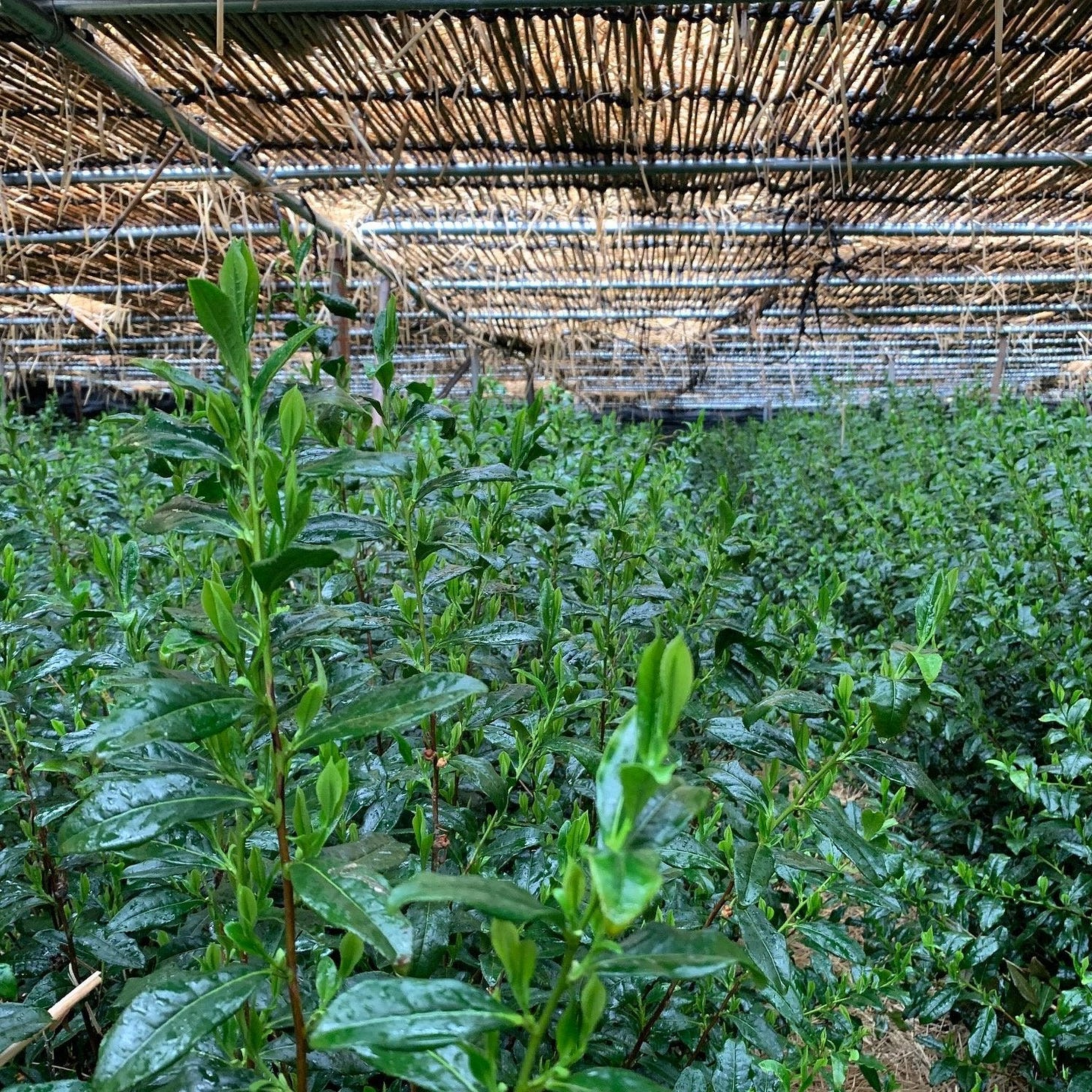Welcome back to Tea Tidbits! We finished our journey to China together but we have a new travel plan coming up! Stay tuned!
(But first, let’s talk about shade and how it effects tea leaves!)
What is tea shading?
Shading tea can be done in two ways, naturally shading tea is when shade is provided by mountains, fog, or tall trees. Artificial shading reduces the amount of sunlight that reaches the tea plant, this is usually done by placing materials over tea bushes. The shading structures are usually made of bamboo, reeds, straw, and cloth. Within artificial shading, there are a few different categories (which I break down below so stay tuned).
Jikakabuse (direct shading) - This is the simplest and cheapest method of shading. A black cloth is draped over plants which blocks 70% of sunlight. A second layer of cloth is put on top of the original cloth which then blocks 95% of sunlight in total. Since the cloths are put directly on the tea plants, the plants are machine trimmed to achieve a flat, equal surface.
Kanreisha (shading with cloth) - This is the most common shading method in Japan. A pole is built and black cloth is draped to form a canopy over the tea leaves. With a gap between the tea plants and the draped cloths, this allows moisture to circulate and lets the plants grow freely. When tea plants are allowed to grow freely, this elevates the quality of the tea leaves. (the leaves only hand harvested when they are grown freely).
Honzu (shelf shading with straw and reeds) - This is the most traditional shading method which dates back over 400 years. This method uses a screen that is made of woven reeds which create the first layer of shade. This screen of reeds allows air and moisture to circulate around, which creates complex flavors in high quality tea leaves. More shading is continued by placing matts made of straw on top of the reed matts.
Let’s dive into some history about tea shading!
China and Japan are known for producing shaded tea’s. The practice of tea shading started in China where the Camellia Sinensis plant was grown on shady hills and foggy mountains. In the 16th century shading tea had grown to Japan and tea producers were shading tea’s in order to protect the early leaf sprouts from frost and extreme weather. During the Sengoku era, the development of shading coincided with Japanese tea ceremonies. Before tea shading came to exist, matcha was an extremely bitter drink with white foam. In Japan, Matcha, Gyokuro, and Kabusecha (These are all green tea’s) are the three tea’s that are shaded.
When do tea’s get shaded?
Usually, tea’s that are shaded get decided by the tea farm but the shading process starts generally between the new bud and the first leaf. Tea’s can be shaded for certain amounts of time but the first 7-10 days they are shaded to 70% of sunlight blocked then up to 95%; certain tea’s can even be shaded to have 99.9% of sunlight blocked.
How does tea shading work?
Camellia Sinensis can convert electromagnetic energy like light into chemical energy via photosynthesis (obviously). The tea plant is abundant in chlorophyll which absorbs visible light such as red-orange to reflect green. The tea plant is also abundant in carotenoids which create the amazing aroma’s of teas.
Plants need sun but too much sun can slow growth and damage the plant’s delicate leaves. Too much sun can also break down chloroplasts which are vital to photosynthesis causing all mechanisms to break down. By decreasing the light that hits the leaves and the angles sunlight reflect on the tea plants, the tea plants will grow horizontally. With less sunlight, photosynthesis slows down efficiency rates and produces excess chloroplasts and chlorophyll to harvest all the sunlight it receives. This increase in chloroplasts and chlorophyll creates very dark and vibrant green tea leaves.
What are the benefits of shading tea’s?
Shading tea can decrease the phenolic compounds that have a bitter taste and increase the aroma compounds in teas. Shading also decreases the fiber content, but in cases like making matcha this is great because it is easier to dry and ground the leaves. Shading also effects the color and chemical components of new tea leaf shoots. A few studies shows that different types of shading intensities can change the chemical components of matcha. Caffeine levels increase when the tea leaves are shaded. Not to mention, shading creates a green refreshing and pleasant aroma.
(I’ll be adding in some number info just so you can see the difference between shaded and unshaded tea components!)
Shaded Tea’s (g/100g): Amino acid content Catechin content
Matcha
Amino acid content- 5.50 Catechin content- 7.83 Caffeine content -3.29
Gyokuro
Amino acid content- 4.77 Catechin content- 10.74 Caffeine content - 3.84
Unshaded Tea(g/100g):
Sencha
Amino acid content- 2.94 Catechin content- 13.44 Caffeine content - 2.64
(All of these compounds except Catechin’s were higher, this is due to shading! So wild right!?)
I hope you all enjoyed my niche deep dive into Shaded Tea’s. I will add a fun, random, niche deep dives in between countries! I would love if you could drop some idea’s or things you want me to expand on that interest you for these niche little tea posts between countries. I hope you all have enjoyed this as much as I have, I can’t wait for to journey with you starting next week toooo… Japan!









I’ve been drinking tea all my life and never knew such a thing existed. Wow. Very interesting.
Thanks for the post. In your research did you find any examples of tea plants being shaded by humans in China prior to or after the human-powered shading began in Japan? I know you mentioned natural shading (clouds/mist/mountain shade) but was wondering if China had its own shading methods before or after Japan’s methods began.